By Sarah Lovely
Bachelor of Science, majoring in Environmental Studies and Geography
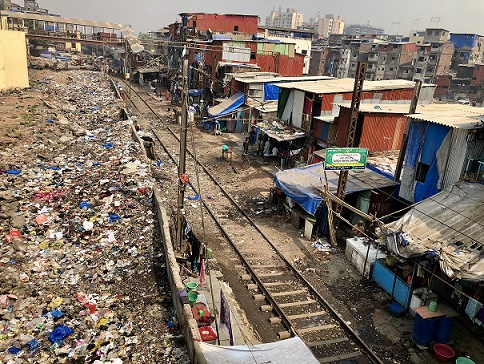
Despite the stark visibility of the rubbish littered throughout Mumbai, the average Indian only uses about 12kgs of plastic per year, which is approximately one tenth the average American usage. In addition to this, around 60% of India’s plastic waste is recycled, whereas the global average is merely 14%. This is thanks to a combination of street-picker based recycling that dominates the sector, as well as many start-ups focused on circular economy entrepreneurship.
The Indian government however, expects to double per capita consumption of plastics by 2022 as petrochemical investment is a lucrative business and reflective of high economic growth in other developed countries. Simply put, history has demonstrated that countries with higher plastic use correlates with higher levels of national wealth. Although increasing consumption to 22kgs per person might not seem alarming when compared to other developed countries, the sheer scale of India’s population functioning without a formal waste management system gives reason for serious concern.
Local governments are starting to roll out bans on ultra-thin polyethylene bags and Styrofoam based products and the national government is proposing a ban on PVC materials. These are fantastic initiatives by India to reduce plastic pollution and move towards a cleaner future for the country. Such measures are made only more impressive when I look back to Australia’s own pitifully slow pursuit of phasing out lightweight plastic bags in supermarkets.
India has been called the land of contradictions for a long time, and this appears to be testimony to exactly that. My observations travelling through Mumbai and south-western India reveal India’s love-hate relationship with plastic.
After visiting Deonar dumping ground in Mumbai which is the largest and oldest dumping ground in India covering almost 1.5km2 and reaching over 35m high, I am concerned about which of India’s contradicting plastic waste arguments will triumph in the end. I mistook the dumping ground as rolling hills it was so massive, vegetation covered the older sections of the dump while trucks could be seen offloading their contents into other parts.
Amongst all the towers of rubbish human scavengers were hauling bags of recyclable materials off the dump to sell from various informal shops in the city. With continued use of plastics, how much will collect on the sidewalk and in waterways and how much of it will start to overflow from over-sized dumps such as Deonar onto the marginalised housing settlements surrounding it?
Author: Elizabeth Hill
Unintended Consequences in Delicate Environments
By Lachlan Perris
Bachelor of Engineering (Civil)2015, Currently enrolled in B.Sc. (Geography, Geophysics)
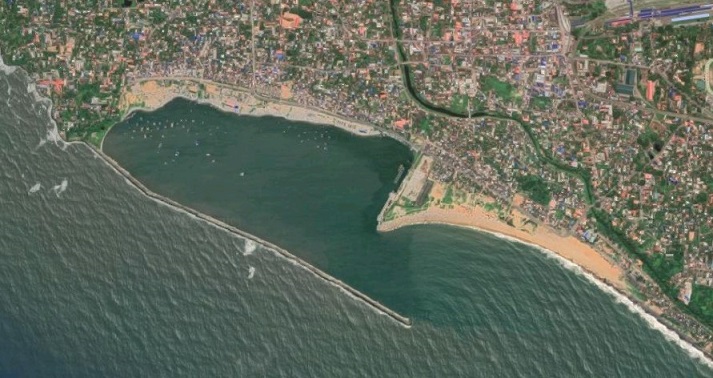
The Eravipuram seawall
The story of the India’s West Coast begins about 100 million years ago when a large rift formed between the Madagascan and Indian landmasses. India’s new coastline emerged as a 1000 meter cliff face to the Western Indian Ocean below. This cliff face still stands today, surrounded by its eroded sediments, as a mountain range known as the Western Ghats.
Today, the monsoonal rains that seasonally slam into the Western Ghats deliver over 2000mm of rain in a few short months, filling rivers and rivulets that flow into the Keralan Backwaters. These backwaters consist of 900km of interconnected canals and lakes shaped by low barrier islands that moderate the mixing of fresh water with Arabian Sea. These complex estuarine environments create unique ecosystems of brackish water, a hotspot for biodiversity and a source of livelihoods for many Indians living along its banks.
Following sediment flows from the Western Ghats into the Arabian Sea provides insights into the complexities of coastal livelihoods while acting as a method for explaining the dynamisms coastal environments. Today, the morphology of the backwaters and the Keralan coastline is changing more rapidly. Anthropogenic influences have seen greater coastal erosion, increasing the backwater sensitivity to salt intrusion, coastal flooding and altered habitat characteristics of the fishing grounds. The reorganisation of these spaces can have devastating consequences on the communities that rely on the ecosystems for their livelihoods and cultural identities.
Developments on the low barrier islands of the backwater ocean interface leads to salt intrusion. To limit the harmful effects of salt intrusion on rice crops south of Kochin, the Keralan government constructed the Thanneermukkom Barrage, dividing the Vembanad Lake in southern Kerala. The barrage was successful in minimising some of the negative impacts of salt intrusion. However, the Ashoka Trust for Research for Ecology and Environment (ATREE), an NGO, has attributed the barrage to reducing sediment flow out of the backwaters and into the Keralan coast. This reduces the overall sediment budget of Keralan beaches and leads to increases in coastal erosion.
The most immediate response to increased coastal erosion is to construct seawalls and groins. Attempts like these to influence coastal morphology often lead to unintended results down stream. Sea wall construction to minimise coastal erosion of one area, for example the Eravipuram seawall pictured above, has directly lead to 500-800m of beach vanishing south of the seawall. Technological interventions such as these require a large amount of capital to construct. The power to do so often falls into the hands of the state, being influenced by aquaculture and tourism lobby groups. The local fishing communities, who had docked their family-owned boats on now non-existent beach, were not consulted.
This story, like many attempts to understand any aspect of Indian livelihoods is far more complex than can be outlined in a brief blog post. Yet, following these sediment flows across the Indian West Coast today demonstrates an approach to understand the dynamism of Kerala’s coastal environments and wetlands. Coastal erosion and sediment transport are a complex processes modified by myriad of climatic, hydrodynamic and anthropogenic processes. Uncertainty exists around how and where technological influences need to be made. Consultation with communities that depend on the morphology and ecology of these spaces for their livelihoods is a good place to begin.
Hey Kerala, what are you working on there?
By Stan Cheung
Bachelor of Arts in Political Economy and Mathematics
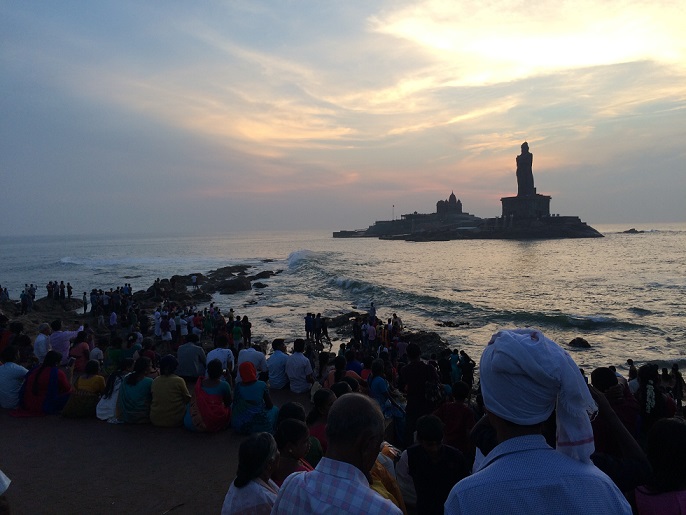
People from all walks of life awaiting the sunrise at Kanyakumari, Tamil Nadu, the southern-most tip of India
As we travel across Kerala, a coastal state in India’s south-west, it’s a funny thought that everyone we see is busy with something or other. Everyone has somewhere to go, someone to see, something to do. Taken together, we are supposed to see a society that is developing. But that becomes a far more complex story. What is development? What are the Keralites busy with?
We could try and understand Kerala’s development by looking at the data. Yet this tells us conflicting stories. On the one hand, Kerala has the highest life expectancy and literacy rates among the Indian states. On the other hand, Kerala’s average growth in income is at a rate about half the national level, and the state ranks highest for unemployment and suicides. We are left with more questions.
Visiting Kerala has revealed glimpses of the deeper story behind the figures. We found that a key part of Kerala’s approach to development is its emphasis on having the people decide for themselves what development consists of and how to go about it. We saw this in the way the Keralan state directly funds local governments, or panchayats, who have substantial autonomy over the use of these funds. In Meenangadi, a panchayat of Kerala’s north-east, funding was granted for a project to make the panchayat carbon neutral: to have no net release of carbon into the atmosphere.
For me, this was a surprise: why would a local government take it upon themselves to combat climate change? And, perhaps the bigger question: was this even possible at the local government level? We were able to pose these questions directly to the panchayat president.
The president informed us that the community actively participates in envisioning their own futures and that they recognised that any future that doesn’t address climate change is no future at all. The community were not blind to potential challenges. It was acknowledged that the panchayat has limited land ownership and was only funded the equivalent of 2 million Australian dollars. With a strategy to plant additional trees, limited land posed a problem. But it was clear to me that these were challenges the community is willing to face.
The question then becomes whether the broader economic, political and social context allows communities to face such challenges? I am reminded that Kerala’s development stands in contrast to the rest of India. The wider context in which Indians go about their daily lives seems less concerned about having active participants in the development process, and more concerned with finding clever development strategies that benefit passive recipients. It is a context that takes away the capability of those involved to imagine for themselves what development really means.
So, what are the Keralites busy with? I think it’s best that we ask them.
A tourist talking tourism
By Raiya Courtier-Sadhu
Bachelor of Liberal Arts and Science majoring in Socio-Legal Studies

Photo: houseboat on Vembanad Lake
After being in any country for just over one month you would expect be accustomed to the contrasting surroundings. Travelling through four states in India; Gujarat, Maharashtra, Kerala and Tamil Nadu, I have found India to be a very diverse nation with differing laws and regulations, landscapes, religious customs, languages, and levels of prosperity and need. India’s constant ability to evolve from state to state is unusual for western visitors. Walking through urban streets and rural towns, I am approached by locals asking me for a photo, children pulling my arm wanting me to meet their family, or simply strangers waving with excitement. Despite being half Indian, India is far from my reality and the reactions I’ve received from locals has continuously reminded me that I am one tourist among thousands.
India is categorised as a ‘developing’ nation and is often viewed through a ‘third world’ lens by westerners. This includes poverty. Slums and famine are what come to mind when many western tourists think of India. Before I arrived in India, people warned me about the shock I might experience on account of the contrast between the majority of Indian’s living standards and my own. For some this sense of shock is scary and saddening, possibly eye opening, and for some it even provokes gratitude for their own daily life. Despite one’s reaction to this sense of shock, I believe it is a key motivation for westerners wanting to travel to India.
This week our studies took us to Alleppey. Alleppey is a tourism hub in South India, known for the houseboats that travel and dock through the beautiful backwater canals and Vembanad Lake. We spent half a day on a tourist houseboat and visited a local NGO that outlined the social-ecological degradation occurring in various ecosystems within the lake. The NGO workers talked about how increasing numbers of houseboats taking tourists onto the lake impacts the environment. We learned about increasing pollution and rubbish that houseboats seep into the lake and canal, threatening the existing biodiversity and fish populations. In Alleppey, 1.5 million people are dependent on the lake, but the excessive use of houseboats for tourism and economic growth are leading to a ‘tragedy of the commons’, ruining the space for all 1.5 million dependents.
This lead me to question the role of tourism in India, and whether tourism industries like the Alleppey houseboats prioritise economic growth over sustainability. Tourism in India contributes less than 10% of GDP with the majority of activity driven by domestic tourism. Environmental sustainability needs to be more of a focus if tourism is to continue to contribute to economic growth.
The bumpy road to Indian development
By Lachlan Mitchell
Bachelor of Science & Bachelor of Arts, majoring in Environmental Studies, Environmental and resource economics, & Geography.
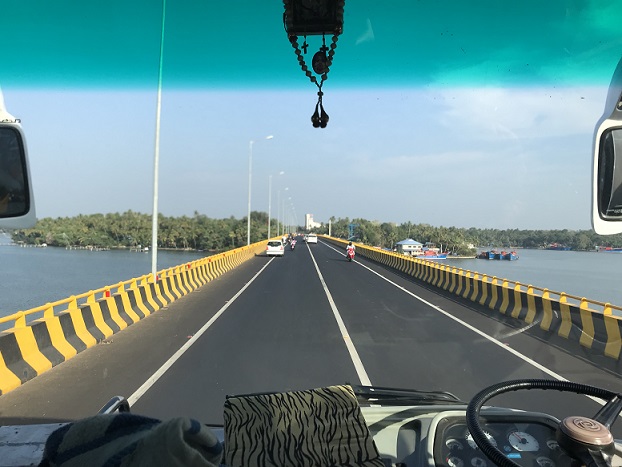
We have spent a lot of time on the road in India. In our 10 days in Mumbai, I spent close to 12 hours in coaches, autorickshaws and Ubers and in our 10 days in Kerala, we have spent close to 60 hours in our (thankfully) air-conditioned coach, called ‘Prakash’. These adventures have not only brought with them many memories of sensational road-side chai and banana fry but have also provoked my thoughts about priorities of development in India, especially in regard to road infrastructure.
The city of Mumbai appears to be perennially gripped by a motorway-building initiative. While we bumped along pothole-ridden roads alongside informal settlements in a Suzuki Swift Uber, elevated, multi-lane highways were towering half-built above us. The road infrastructure designed to rid the city of its chaotic traffic jams was finally being built. Yet contrasting priorities of development were evident. From our coach driving along the top of one of these motorways, you could see dinner being cooked through the glassless windows of fourth floor slum residents.
From an Australian perspective, it is always encouraging to see infrastructure development, however I can’t help but feel torn seeing it in Mumbai. These new motorways will play some role in easing Mumbai’s congestion challenges. I question, however, whether this investment, comes at the expense of essential quality of life changing development needed in many of Mumbai’s slums.
In Kerala, I have seen a different side to the Indian road network. Our first few days in Kerala involved a mammoth 9-hour bus ride covering just 200km. At first, I couldn’t understand why there were no motorways connecting Khozikode and Kochi; we had travelled along the main roads of towns the entire route and had been slowed by Saturday afternoon traffic and festivals. However, after reaching the newly opened dual-carriageway leading to Trivandrum over a week later, I started to understand two things: firstly that Keralans’ livelihoods are based in their local villages and there is little need to commute large distances regularly; and secondly that the Keralan government was prioritising more important roadworks.
In last year’s monsoon, Kerala experienced the worst flooding in 94 years. Many of the roads on which we travelled were completely destroyed just a few months ago but were already under repair or repaired by the time of our visit. The roadside areas were teeming with workers reinforcing the mountains and re-tarring the road. In our time in Munnar, we arrived at our hotel on a dirt road and two days later, when leaving, the road was freshly tarred. The efficiency of these road repairs is far from what I would have expected.
Some of the parting words I received when leaving TISS in Mumbai were “Enjoy Kerala! Kerala is the best part of India, but it’s not India.” Having travelled by road both here in Kerala and back in Mumbai, I can start to understand what was meant by that. Kerala seems to have kept road development priorities in check with the demands and challenges faced by the broader community. Repairing the roads in Kerala is essential for Keralans’ livelihoods and tourism alike. Mumbai, on the other hand, continues to perplex me and I hope to continue to learn more about underlying factors influencing development priorities in that city. The Keralan difference is refreshing and encouraging, and gives me hope for what is to come for India in the decades ahead.
Are dogs really a man’s best friend?
By Siobhan Herbert
Bachelor of Economics and Arts, majoring in Economics, Political Economy and Government and International Relations.
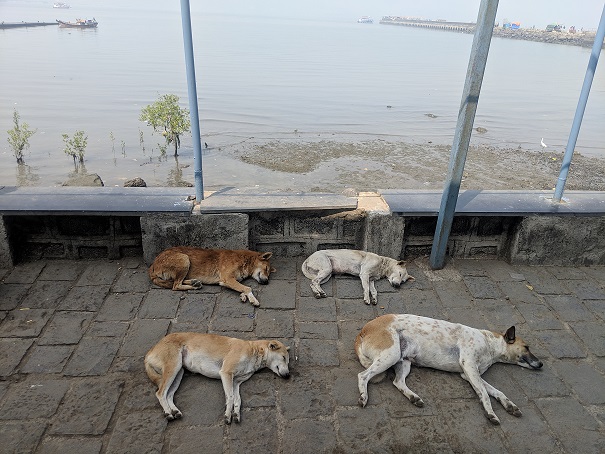
It’s well known that India’s stray dog population presents a unique set of challenges for the developing nation. As an avid dog owner, I knew seeing conditions of these dogs would come as a shock. However, their distribution is also representative of broader patterns of development and the need for better governance in India.
Before leaving for the field trip to India, my friends and family joked about having to resist patting the dogs that roam Indian streets, for a fear they may carry rabies or other diseases. With 35 million stray dogs in India, it is no surprise that rabies is so prevalent. The World Health Organization reports India faces around 18,000 to 20,000 cases of rabies every year. These numbers show no sign of decline, sparking debate and calls for the Indian government to implement policies to control the stray dog populations.
Upon arrival at the Tata Institute of Social Sciences (TISS) Campus in Mumbai, we were welcomed not only by our student coordinator, but also a group of dogs. These dogs had taken up permanent residency on the campus, appearing surprisingly well treated, fed and sheltered. Perhaps my expectations about the health dangers posed by dogs had been misplaced? However, a trip the following day to downtown Colaba left me reconsidering.
Amongst the crowds and chaos that defines the Colaba district, starving dogs filled the streets, crossing the commotion of Indian roads to find something to seat amongst the street rubbish. It became evident that there is a direct correlation between open garbage and the stray dog population, as they rely on this rubbish for limited food supplies and survival.
This correlation was further demonstrated in my travels through the southern state of Kerala. Kerala is renowned for its progressive social development, despite having a low per capita income and nearly stagnant economic growth. This human development approach has led to Kerala having the highest life expectancy, sex ratio and Human Development Index amongst all Indian states. Not surprisingly, these statistics are reflected in the lesser number of street dogs.
However, the stray dog population still presents challenges for Kerala, meaning there are factors contributing to this issue beyond the low human development and open garbage observed in Mumbai. The dogs often attack people which leads to citizens taking the law into their own hands. In November 2016, the Supreme Court ordered the Kerala Government to find solutions to stop increased killings of stray dogs, as culling is not a humane or sustainable solution.
Kashika Arora, a pet management entrepreneur, summarises this argument with her statement ‘Stray the word itself is wrong. They are our Indian breeds, which we Indians don’t want to accept’. As the perceived low worth of stray dogs influences their population and treatment alongside direct factors of garbage and development levels, the issue requires urgent attention. Rather than treating dogs as dirty and stray, India needs to find sustainable ways to control their populations whilst transforming perceptions to view them as man’s best friend.
Down and Out in Dharavi
By Julian Sheldon
Bachelor of Arts, majoring in Political Economy and Philosophy

Photo: Dharavi main street vendors
When you try to imagine one of Asia’s largest slums, chances are you don’t think of a bustling productive hub with an annual turnover of close to a billion dollars. Nonetheless, this is the reality of Dharavi, Mumbai’s largest slum.
We tend to have certain images that spring to mind when we think ‘slum’: images of starving children, beggars, and shacks made of corrugated iron and tarpaulin. Slums are imagined as the ultimate embodiment of poverty, a place where our presence could only ever be an intrusion. In other words, they’re not exactly tourist destinations. Nonetheless, after deciding to completely ignore all of this, I found myself spending a fine Sunday morning hopelessly lost in the heart of Dharavi.
Is it wrong to say that Dharavi was actually quite nice? There’s a bustling main road, bursting with shops selling fresh fruit, local handicrafts and electronics. Delve into the labyrinthine side-streets, and you find that instead of run-down shacks held together by equal parts tape and willpower, there’s actually sturdy concrete homes, decorated with flowers and colourful curtains. Children play soccer in the street or men pause for a chai; in short, Dharavi has its own vibrant community.
It’s through this that you can begin to see that slum-dwellers are not just passive victims of poverty, but rather create their own livelihoods within the slum. There’s a vast economic ecosystem in Dharavi; recycling businesses process the waste from central Mumbai, whilst approximately 15,000 small informal factories produce anything ranging from leather goods to luggage, exporting them across the world.
Now, please don’t get the wrong idea; slums are objectively terrible places. The problems are too numerous to cover, but include the rapid spread of communicable diseases, the prevalence of dangerous illegal electricity connections, and high rates of crime and mortality. Not only that, but Dharavi’s prosperity is an exception amongst slums; each slum is its own wholly unique community. What ties them together is that they present a serious development problem that ought to be addressed.
There has been an endless procession of proposals to redevelop Dharavi, however they’re not necessarily proposed for humanitarian reasons. Dharavi is situated on incredibly valuable land in the heart of Mumbai, meaning that redevelopment proposals begin with developers and their visions of expensive apartment blocks and commercial zones, and then treat the rehabilitation of slum-dwellers as an obstacle to these goals. As such, the free formal housing that slum-dwellers are sometimes rehabilitated can be worse than the slums themselves – often overcrowded and far from employment locate on the outskirts of cities.
What any solution to the problem of slums needs to include is an understanding that slums are much more than just a space of poverty: they’re equally a market, a workplace, and a vibrant community. Solutions must start from the bottom-up and include those who live there. This isn’t an easy solution, but for the people of Dharavi, it might just be a necessary one.
Is the tea really greener on the other side?
By Miranda Evans
Bachelor of Science, majoring in Geography and Neuroscience.
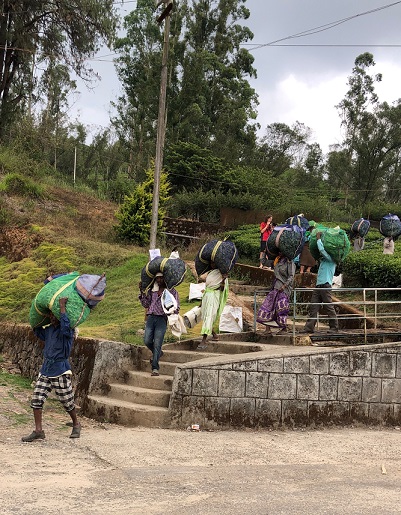
Photo: Tea pickers in Munnar
Every minute, 30 people are migrating from rural India to urban areas. There’s no doubt India’s major cities are facing incredible challenges to accommodate the influx. During our first week in Mumbai, this was our focus. But as we travelled south to the state of Kerala, we began to look at the migration story form the rural side of the equation. An estimated 10% of Keralans live outside the state. Migration has been beneficial for reducing the state’s poverty rate and relative deprivation. But what does it mean for employment?
1,600 metres above sea level is the town of Munnar, surrounded by rolling hills filled with tea plantations. On a visit to the Munnar Tea Museum, we spoke with a group of women teapickers as they deposited their 25kg bags of tea leaves from their day’s work. The women proudly told us their children have left Kerala to study commerce and medicine and other forms of higher education. Education provides an important pathway for social mobility.
Tea plantation workers are among the lowest paid workers in Kerala and at the bottom of the labour market. Their typical work day is 10 hours long, 6 days a week. Women work on the field, delicately plucking the new tea leaves. Men are employed in the factories as ‘unskilled’ labourers. The manager at our hotel told me he was from a family who traditionally worked in the tea plantations. But his parents didn’t want him to follow them into this industry given the tough working conditions. As we were talking another hotel employee sat down next to me. He had spent seven years working in tea factories prior to seeking employment at the hotel. The hotel manager told me that once you enter the industry, you are locked in and it is hard to leave as you are dependent on your employer to supply drinking water, housing, food, education and healthcare. The hotel employee told me he wished he had moved to a city like most of his friends, as life was too dependent on local industries in Munnar. This made me wonder how tea plantations were finding employees if the locals were no longer interested in working in Munnar’s leading industry.
The answer I found was migrant labour. Hopeful migrants from the northern and eastern Indian states have moved to Munnar and tea plantations across Kerala seeking safe and sustainable working conditions. Despite having no skills or previous experience in the sector, the shortage of local labour has forced plantation management to employ these people. Plantations strategically hire migrant families knowing they are reluctant to move away once settled into local communities. These families move to Kerala with hope for a prosperous new beginning in the lush hills of southern India. When faced with the harsh reality of the tea plantation industry, I wonder is the tea really greener on the other side?
Inclusive Education – Srishti Welfare Centre
By Nikki Stevenson
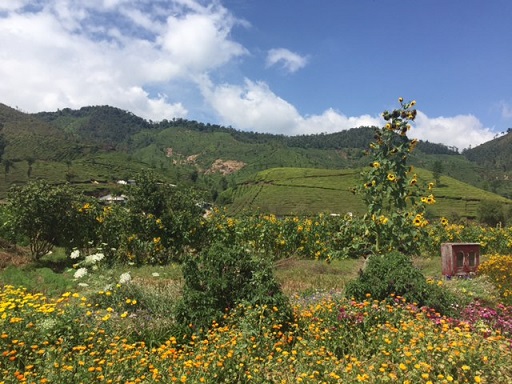
Travelling from Mumbai south to Kerala, the poverty observed is confronting but most definitely thought provoking. India’s poverty is heavily influenced by the caste system. Being low caste places restrictions on all aspects of one’s life – especially work opportunities. Low caste communities dominate strenuous and hazardous work roles. For disabled people of low caste the challenge of finding decent work is especially tough. The Srishti Welfare Centre aims to support these workers.
The Srishti Welfare Centre is a private organisation that provides education, paid work and vocational training to children and adults with a disability. Located in the picturesque countryside of Munnar, in the state of Kerala, the welfare centre is set amongst the mountains, with a lush garden of colourful flowers, vegetable patches, and a well-used children’s playground. What Srishti achieves as a welfare centre is extraordinary. Education is a key focus. Srishti accepts children from as young as 3 and a half years old and allocates them into classes based on their ability, rather than age. The teacher to student ration is generally 1:8, with students instructed in the Tamil language, but also taught English, and sign language, as many of the students have hearing aids.
Most of the students at Srishti are the children of local tea plantation estate workers. These children are provided transportation to and from the centre with some students travelling up to 30kms one way. Students are also provided with meals and all learning materials. The Centre is funded by TATA – a multinational conglomerate company that owns many of the tea plantations in Munnar.
Srishti also offers vocational training. These skills are taught from the age of 16 and include food processing, market gardening, training as pastry chefs producing goods for an on-site bakery, fabric dying and garment making, and paper making. All the products are sold in the Indian market and to tourists visiting the welfare centre. The proceeds are than circulated back into the centre to further support the education and skill enhancements of children and adults with disabilities. Srishti also supports their graduates find employment outside the Centre.The Srishti Welfare Centre is a clear example of an organisation that supports disadvantaged communities often overlooked by government welfare systems.
Beyond the hierarchy – ‘possibilities for a non-alienated life’
By Victoria Booth
Bachelor of Science, Immunobiology and Geography
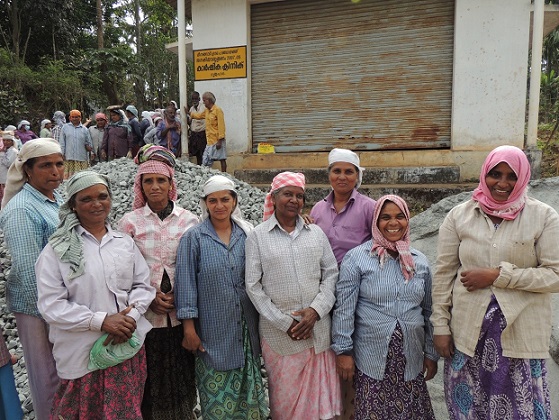
Photo: Women working as part of the NREGA Scheme within the Wayanad District of Kerala
‘Dear friends’ begins an old, crumpled notice pasted on a chipping wall of the games room of the TISS campus. The notice was concerned with the borrowing of sports equipment and concluded by extending a “warm welcome” for any students’ “suggestions and advice”. I was there to play ping-pong but my mind immediately began to whir. In its own small way, the notice was rebelling against a deeply-rooted mindset; the mindset of hierarchy. According to Shirish Patel (2010), ‘Indians have an ancient belief extending over millennia that all men are fundamentally unequal’. The sad legitimacy of this statement was continually re-enforced by our lecturers at TISS: They consistently described the caste-system hierarchy as debilitating tool of persistent oppression, with one lecturer likening this deep-rooted social ranking to a ‘virus’. Another lecturer quoted Dr Ambedkar: ‘Turn in any direction you like, caste is the monster that crosses your path’. Their examples were alarming; in some parts of India girl-children are named Nakusa, meaning ‘unwanted’ in Hindi. Suffering from the same ancient hierarchical belief, Dalits, forced into the lowest-paid jobs, have come to be the primary inhabitants of urban slums.
Interestingly, the extent of lower-caste dispossession has prompted many to convert to Buddhism in order to escape the unjust hierarchy. Movement beyond the hierarchy is taking place, with a positive momentum towards equality. In the political arena, the Constitution has taken up the role of an ‘antivirus’. Whilst it does not begin with “Dear Friends” it’s close enough:
“WE, THE PEOPLE OF INDIA, having solemnly resolved to…secure all secure all [India’s] citizens…EQUALITY of status and opportunity”.
We saw this first hand in Meenangadi Grama Panchayat, in Wayanad district.
As we traveled to a forest-rehabilitation site we came across a group of men and women building a concrete path to connect a series of houses. They were working as part of the national Rural Employment Guarantee scheme (NREGA). This is a Constitutionally-prescribed social safety-net designed to reduce inequalities. NREGA provides 100 days per year of paid work (on public projects) to any unemployed man or woman. The pay is equal- regardless of caste or gender. Social and cultural spheres appear to be making similar active steps towards reform, with the phrase ‘possibilities for a non-alienated life’ spread across the entrance of this year’s Kochi Biennale. Whilst it didn’t start with “Dear Friends”, the curators note for the Biennale beautifully articulated the same sentiment of liberation and comradeship.
Curator of this year’s Kochi Biennale, Ms Anita Dube, told us that the Biennale was intended as a ‘space where there could be no hierarchies of who could speak and what could be said and in which language’. Exhibits ranging from the embroideries of a rickshaw driver, poems written by a cotton-mill worker and the recordings of a female Sufi singer allowed visitors like us to understand and empathize with some of the most marginalized in society, via their art.
While I am almost certainly placing undue significance upon a crumpled old notice in the games room at TISS, I feel it embodies the hopeful precedent that both the university, panchayats like Meenagadi and cultural projects like the Biennale are striving for. And on that note, dear friends, as I come to the last week of my trip to India, I am convinced of the possibility that Indian citizens can experience a ‘non-alienated’ future, as the nation slowly moves beyond the hierarchy.

